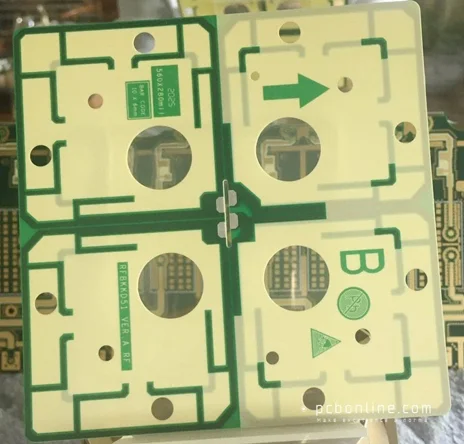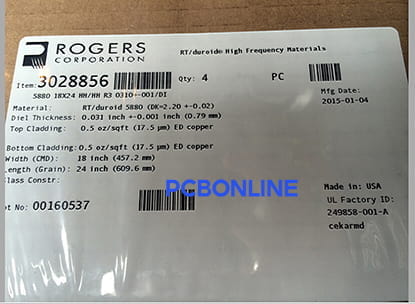
To fabricate your RF or high-speed product, you need to select the right Rogers PCB material for your high-frequency PCB by checking its laminate system, Dk, Df, and suitable applications. At PCBONLINE, we have in-stock high-frequency laminates in our warehouse and can provide Rogers PCB manufacturing and assembly with a fast turnaround. You can send your Gerber to us for one-stop PCB manufacturing or contact us to choose the appropriate Rogers PCB material. If you have no idea of the Rogers PCB materials yet, check this article.
Rogers PCB materials are highly diverse. Based on the material system and application focus, they can be categorized into six main series: RO4000, RO3000, RT/duroid, CLTE, TMM, and Special Applications. Each series has multiple specific models corresponding to different Dielectric Constants (Dk), Dissipation Factors (Df), thermal resistance, and application scenarios, suitable for various high-frequency and high-speed applications.
1. RO4000 series — common high-frequency/microwave materials
The RO4000 series is based on a fiberglass-reinforced, ceramic-filled hydrocarbon resin system (hydrocarbon resin + ceramic filler + glass fiber). It is the only series that can be hybrid-laminated with FR4 to create Rogers FR4 PCBs. The advantages include lower cost and good processability, so it is suitable for hybrid laminate PCBs.

The Dk range for the RO4000 series is 3.0 to 6.15, and the Df range is 0.0023 to 0.0038.
Applications of the RO4000 series:
- 5G communication antennas
- Automotive radar
- RF modules
- IoT gateways
- Microwave power amplifiers
Rogers R4000 common models:
|
Model
|
Dk @10GHz
|
Df
|
Characteristics
|
|
RO4003C
|
3.38
|
0.0027
|
Most classic model, high cost-performance
|
|
RO4350B
|
3.48
|
0.0037
|
Higher heat resistance, lower water absorption
|
|
RO4835
|
3.48
|
0.0037
|
Enhanced oxidation stability (long-term stable Dk)
|
|
RO4730G3
|
3.0
|
0.0023
|
Low dielectric, suitable for antennas and millimeter wave
|
|
RO4360G2
|
6.15
|
0.0038
|
High frequency + high Dk design (compact antennas)
|
2. RO3000 series — high-end microwave/PTFE system materials
The RO3000 series is based on a ceramic-filled PTFE system. Advantages include extremely low dielectric loss and highly stable Dk. The Dk range is 3.0 to 10.2, and the Df is 0.0010 to 0.0027.
Applications of the RO3000 series:
- Millimeter wave radar
- Phased array antennas
- Satellite communication (Satcom)
- Microwave filters
- Base station array boards

Rogers R3000 common models:
|
Model
|
Dk @10GHz
|
Df
|
Characteristics
|
|
RO3003
|
3.00
|
0.0010
|
Ultra-low loss, classic high-frequency material
|
|
RO3006
|
6.15
|
0.0020
|
High frequency, high Dk, for compact structure antennas
|
|
RO3010
|
10.2
|
0.0022
|
Extremely high Dk, suitable for small antenna designs
|
|
RO3035
|
3.50
|
0.0015
|
Balance of stability and cost
|
|
RO3210
|
10.2
|
0.0027
|
High Dk microwave filters
|
|
RO3203/RO3206
|
3.02/6.15
|
0.0016/0.0025
|
Excellent stability, suitable for phased array radar
|
3. RT/duroid series — pure PTFE high-end microwave materials

The RT/duroid series is a system mixing high-purity PTFE with ceramic or glass microspheres. The advantages are extremely low loss and very high stability. The Dk range is 2.2 to 10.2, and the Df is 0.0009 to 0.0023.
Applications of the RT/duroid series:
- Aerospace and defense radar
- Satellite systems
- Millimeter wave ranging
- Microwave components
- RF Power modules
Rogers RT/duroid common models:
|
Model
|
Dk @10GHz
|
Df
|
Characteristics
|
|
RT/duroid 5880
|
2.20
|
0.0009
|
Classic low-loss model, widely used in millimeter wave applications
|
|
RT/duroid 5870
|
2.33
|
0.0012
|
High stability, commonly used in radar communication
|
|
RT/duroid 6002
|
2.94
|
0.0012
|
Good thermal stability, low thermal expansion
|
|
RT/duroid 6010LM
|
10.2
|
0.0023
|
High-frequency high Dk design
|
|
RT/duroid 6202 / 6202PR
|
2.90
|
0.0015
|
Microwave and power amplifiers
|
4. CLTE series — low thermal expansion ceramic-filled PTFE materials
The CLTE series material system is ceramic-filled PTFE (low CTE), specifically designed for phased array radar and precision phase control systems. Advantages include extremely low Coefficient of Thermal Expansion (CTE), excellent electrical performance, and dimensional stability. The Dk is 2.94, and the Df is 0.0015 to 0.0018.
Applications of the CLTE series:
- Phased array radar
- Aerospace radar antennas
- Phase shifters
- Power amplifier modules

Rogers CLTE common models:
|
Model
|
Dk @10GHz
|
Df
|
Characteristics
|
|
CLTE/CLTE-XT
|
2.94
|
0.0015
|
Dimensionally stable, reliable double-sided plating
|
|
CLTE-MW
|
2.33
|
0.0012
|
High-frequency measurement and millimeter wave design
|
|
RT/duroid 6035HTC
|
2.94
|
0.0012
|
High thermal conductivity version
|
5. TMM series — thermally stable ceramic composite materials (non-PTFE system)
The TMM series is a ceramic composite non-PTFE system. Advantages include a low DTE and high mechanical strength, making it suitable for high-power, high-temperature, and high-frequency circuits. The Dk range is 3.27 to 9.8, and the Df is 0.0020 to 0.0023.
Applications of the TMM series:
- High-frequency power amplifiers
- Filters
- Phase controllers
- Temperature-controlled circuits
- Precision RF modules
Rogers CLTE common models:
|
Model
|
Dk @10GHz
|
Df
|
Characteristics
|
|
TMM3
|
3.27
|
0.0020
|
High-frequency low loss, dimensionally stable
|
|
TMM4
|
4.70
|
0.0020
|
Suitable for filters and phase shifters
|
|
TMM6/TMM10
|
6.00/9.80
|
0.0023/0.0022
|
High Dk design
|
6. Other series (special applications)
The Special Applications series includes the RO2800 Series, AD Series, RO5500 Series, TC Series, and RO7000 Series. These sub-series differ significantly in their materials, characteristics, Dk, Df, and applications, as shown below.
|
Series
|
Representative model
|
Dk @10GHz
|
Df
|
Material system
|
Application
|
|
RO2800 series
|
RO2808, RO2810
|
2.8 to 3.0
|
0.0013
|
Ultra-low loss hydrocarbon composite
|
Millimeter wave 5G antennas, automotive radar, millimeter wave communication modules
|
|
AD series
|
AD255C, AD1000
|
2.55, 10.2
|
0.0015 to 0.0022
|
PTFE + ceramic
|
High-gain antennas, phased array antennas, RF feed boards
|
|
RO5500 series
|
RO5505, RO5510
|
5.05, 10.2
|
0.0018
|
PTFE flexible material
|
High-frequency flexible antennas, flexible RF interconnects
|
|
TC series
|
TC350, TC600
|
3.5, 6.0
|
0.0020
|
Ceramic-filled thermally conductive material
|
High-frequency power devices, thermal management PCBs, power amplifier modules
|
|
RO7000 series
|
RO7360G2, RO7530
|
3.0, 3.3
|
0.0025
|
Hydrocarbon/ceramic composite
|
High-frequency antennas, phased array radar, millimeter wave packaging substrates
|
Parter with PCBONLINE for One-stop Rogers PCBs
If you have a project plan for high-speed or high-frequency applications, whether you have completed the high-frequency PCB design or not, you can work with the one-stop advanced PCB manufacturer PCBONLINE for turnkey PCB manufacturing, including Rogers PCBs.

Founded in 2005, PCBONLINE has two large advanced PCB manufacturing bases, one PCB assembly factory, stable supply chains, and an R&D team.
Provide one-stop Rogers PCB manufacturing, including R&D, prototyping, PCB fabrication, component sourcing, PCB assembly, PCBA value-added, and box-build assembly.
Minimum laser drill: 0.075mm, minimum mechanical drill: 0.15mm, with microvia structures of 100 µm and 125 µm. High-density circuit layers up to 20, and microvia layers up to 64.
PCBONLINE grasps the core technologies for Rogers PCB manufacturing, such as impedance control, embedded antenna DFM, expansion/contraction control, etc.
Have ready-to-use Rogers PCB materials in stock, and the storage period is within 45 days (at manufacturers who have no storage, it usually takes 2 to 3 months to purchase base materials).
Can provide various Rogers PCBs, including automotive and aerospace-grade Rogers PCBs, Rogers FR4 PCBs, and Rogers FR4 ceramic PCBs.
Rogers PCB manufacturing is certified with ISO 9001:2015, ISO 14001:2015, IATF 16949:2016, RoHS, REACH, UL, and IPC-A-600 Class 2/3.
PCBONLINE pays attention to quality and cost-effectiveness in Rogers PCBs. If you want to get a quote or ask questions about Rogers FR4 PCBs, you can send emails to info@pcbonline.com to get a quote.
Conclusion
Choosing the right Rogers PCB materials is important for any Rogers PCB. By checking the Dk and Df values, the material system, and the suitable applications, you can decide which Rogers PCB model to use. If you need Rogers FR4 PCBs/PCBA or need assistance in your high-frequency project, work with the one-stop Rogers PCB manufacturer PCBONLINE.
PCB fabrication at PCBONLINE.pdf




